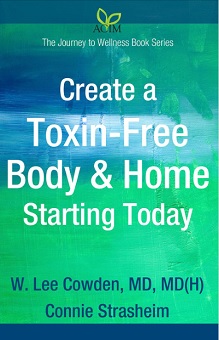Keeping clear water in your metaphorical tub

(Book review) “Create a Toxin-Free Body and Home Starting Today,” by Dr. Lee Cowden and Connie Strasheim.
Here’s a common scenario in my Lyme disease support group: Partway through a newbie’s first meeting, the person cautiously raises his or her hand and says, “Detoxing. You guys are all talking about detoxing. I don’t even know what that means.”
And then people start explaining: Dying spirochetes give off biotoxins in the blood stream, making your symptoms worsen. Though it’s technically known as a Jarisch-Herxheimer reaction, Lyme patients typically just call it “herxing.” Various methods can help “take out the trash.” Regular detoxing often helps the person feel better.
However, a new book called “Create a Toxin-free Body and Home Starting Today,” says detoxing is not just for Lyme patients trying to stop herxing in its tracks. According to the authors, everybody—healthy or not—needs ways to protect themselves from the onslaught of environmental toxins which permeate our surroundings every day.
Co-authors Dr. Lee Cowden (creator of the “Cowden Protocol” for treating Lyme disease) and health writer Connie Strasheim (author of seven books on holistic wellness) start out by offering “the bathtub analogy.”
Imagine your body is a bathtub with many faucets. Some bring in good stuff and some bring in bad stuff. There’s also a drain at the bottom of the tub.
If too much bad stuff (pollution, pesticides, allergens, etc) go in, it can overwhelm the good stuff (pure water and food, fresh air, etc), and clog the drain in the process. The result? You’re stuck with a tub full of filth and no way to get rid of it. Having your body awash in dirty water is NOT the way to get or stay healthy.
Say the authors: “In this book we will teach you how to drain harmful environmental toxins from your tub, as well as how to pour into it healthful remedies and practices to replace those that caused it to be dirty and overflowing in the first place.”
Part One of the book deals with creating a toxin-free body, discussing such topics as food, water, and assorted toxin removal strategies such as liver and gall bladder flushes, lymphatic drainage and saunas.
Part Two involves creating a toxin-free home, covering subjects such as household cleaning products, carpeting, furniture, and mold.
Some of suggestions are complex and expensive—perhaps replacing the flooring in your house with non-toxic alternatives. Other remedies are easy and cost nothing—such as removing your shoes before you enter the house.
Say the authors: “Even though DDT is no longer used in the United States, the half-life of DDT in grass is up to fifty years, which means that a large part of what was sprayed on the grass in years past is still in the soil and some of us are stepping into that soil and tracking DDT into our homes. That DDT then gets into the carpet and air of the home and we end up breathing it.”
So keeping two pairs of shoes—one for outside, one for inside—and switching them at your door, can go a long ways towards reducing toxins in your home.
This is the first title in a planned series of books called “Journey to Wellness.”
TOUCHED BY LYME is written by Dorothy Kupcha Leland, LymeDisease.org’s VP for Education and Outreach. Contact her at dleland@lymedisease.org.




















Thanks, Dorothy, for the informative book review and the small bite size bit of advice about not wearing our outside shoes in the house. It is amazing how unaware I was of the toxins in the environment before I got ill. If I knew, when I began, how complicated my recovery would be and how pervasive the hazards are which can drag me back down if I am not attentive I don’t know if I could have taken the challenge. We all continue to learn and do what we can when we can.